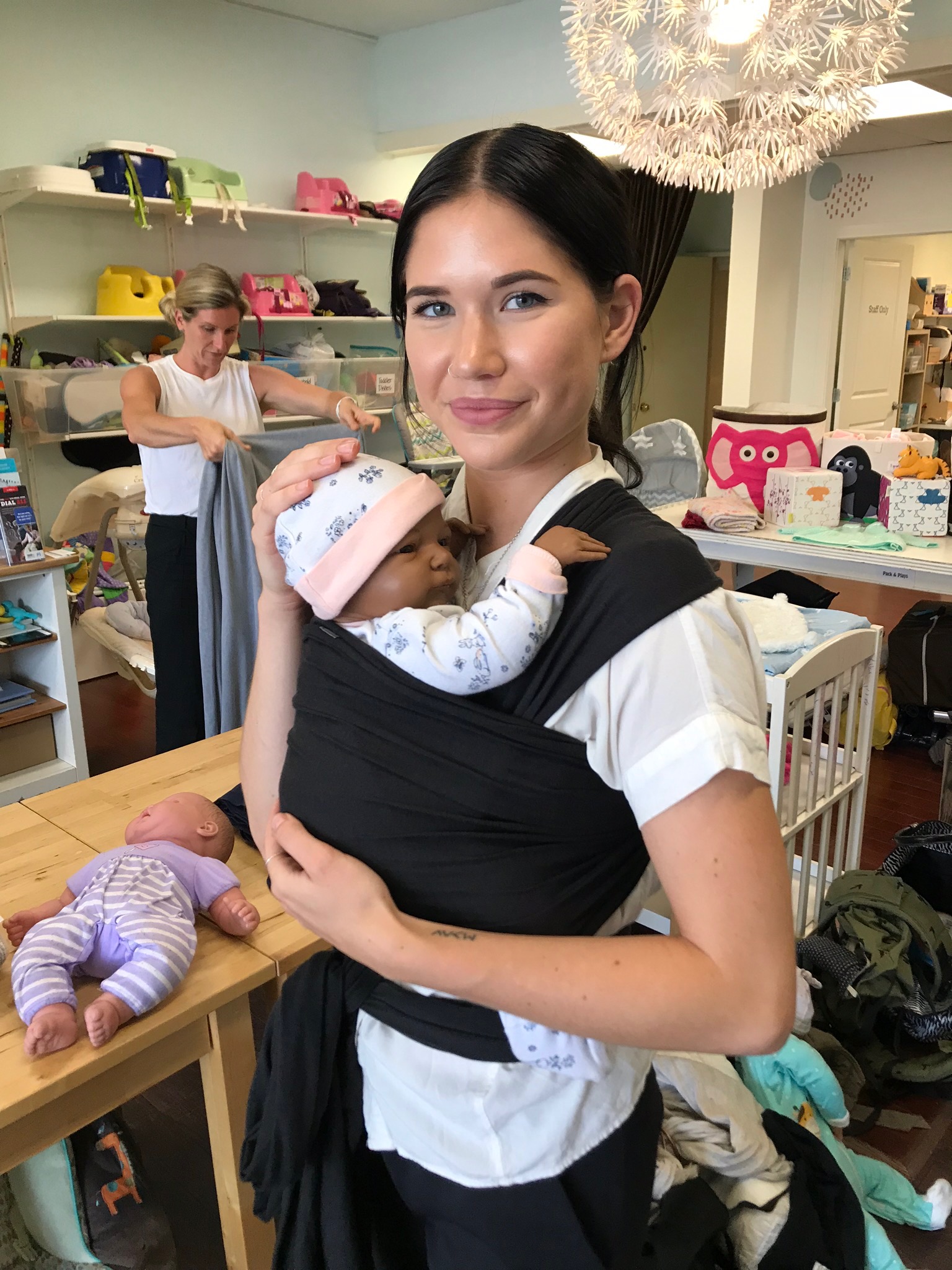So many of our clients feel unsure about trying to figure out how to safely and securely use baby wraps. We wanted to introduce you to Ponnie because she is a trained babywearing educator with the Centre of Baby Wearing Studies.
She is the owner of Ponnie Matin Studios where they are passionate about inspiring others to move, create and love. She resides in North Vancouver with her husband and daughter. Any baby wearing consultation that is booked through BabyGoRound referrals starting mid-August, Ponnie will donate 50% to BabyGoRound! We are so grateful for her contribution to our community!

This month Ponnie is our guest blogger, teaching us all things about Babywearing!
Definition: ba·by·wear·ing /ˈbābēˌweriNG/
noun
The action or practice of carrying a baby close against one’s body in a sling or similar carrier.
Besides being hands-free, practicing the act of Babywearing has many benefits for you and your baby. Did you know to wear your baby just 3 hours a day can reduce crying by 35-43%. Babywearing also strengthens the bond between parent and baby, aids in babies’ physical and emotional development, promotes early language development, neural development, respiratory and gastrointestinal health, and boosts breast milk production. There are many more benefits but I think we can leave that for another blog post.

Often the very first question I am asked after someone finds out that I am a Babywearing Educator is “What carrier should I buy?” or “Which carrier do you recommend?” I bet you are wondering the same thing.
The answer is very simple; the one you love the most, as long as it fits you and your baby comfortably. Think about it this way, not every shoe works for every occasion and not every foot is comfortable in every shoe. Could you imagine going hiking in high heels? Our bodies are all unique, our babies are unique and our situations are all unique. The carrier that will work best for you is one that you can use comfortably and confidently for your needs. On a side note, buy the color and print you, love, you will use it more often. Just because you had a boy does not mean you have to get the blue carrier if your favorite color is not blue!
With an endless array of carriers on the market, which carrier will suit your needs the most? Will multiple caregivers use it? What type of activities do you see yourself doing while Babywearing? What is your budget?
Let me share with you the most common types of carriers to help you narrow it down. If you prefer hands-on help consider booking a consultation with a Babywearing Educator or attend a local meetup or borrow from a lending library.
Wraps- This is the method that is closest to traditional carriers used worldwide. Wraps can be used from birth on. They come in stretchy fabric, good for front and hip carries as well as woven fabrics that also allow for back carries. Wraps come in different lengths and are the most “intimidating” though they really should not be. With a little practice, wraps can offer a huge range of versatility for the wearer from one shoulder carries to more supportive carries with reinforcement to very pretty carries suited for the fanciest of parties. Stretchy wraps are often inexpensive, while woven wraps can get pretty pricey. Both are ideal for use by multiple caregivers.
Ring Slings- Available in a variety of fabrics and lengths, Ring slings can be used from birth. They are easy to share amongst caregivers, however, have a bit of a learning curve at the beginning. Once learned, it is fast to get baby in and out. Ring slings have no waistband and are worn over one shoulder. They are most frequently used to wear baby on the front or on the hip.
Asian Style Carriers- Most commonly this style of carrier has a fabric panel and 4 straps that are tied around the wearer (often called a Meh Dai). With a minimalist feel, these carriers allow for good adjustability and custom fit for babies from day one and are great for use between multiple caregivers. This carrier can be used for front, hip and back carries.
Soft Structured Carriers(SSC) – Like the Asian style carriers, Soft Structured Carriers have a panel, shoulder straps, and waistband. This style of carrier uses padding and offers buckles instead of the ties of the Asian style carriers. A few easy adjustments will be needed to allow wear from multiple users. SSC’s have the smallest learning curve. Some models are good to go from birth while others need an infant insert. Based on the model, they can be used for front, hip and back carries.
No matter which carrier you choose you will be doing a great thing for you and your baby. I’d love to hear from you. Which one do you think will suit your lifestyle the most? What do you see yourself doing while Babywearing? And don’t be shy to reach out if you have any questions.
-Ponnie Matin Pelchat
Ponnie is a Babywearing Educator and Consultant trained by the Center for Babywearing Studies, NY.
Link to how to put stretchy wrap on and baby in.
https://www.instagram.com/p/BzzleSipgc1/
Instagram for any questions and more videos
https://www.instagram.com/ponnster
https://www.facebook.com/ponniematinstudios
Website www.ponniematinstudios.com